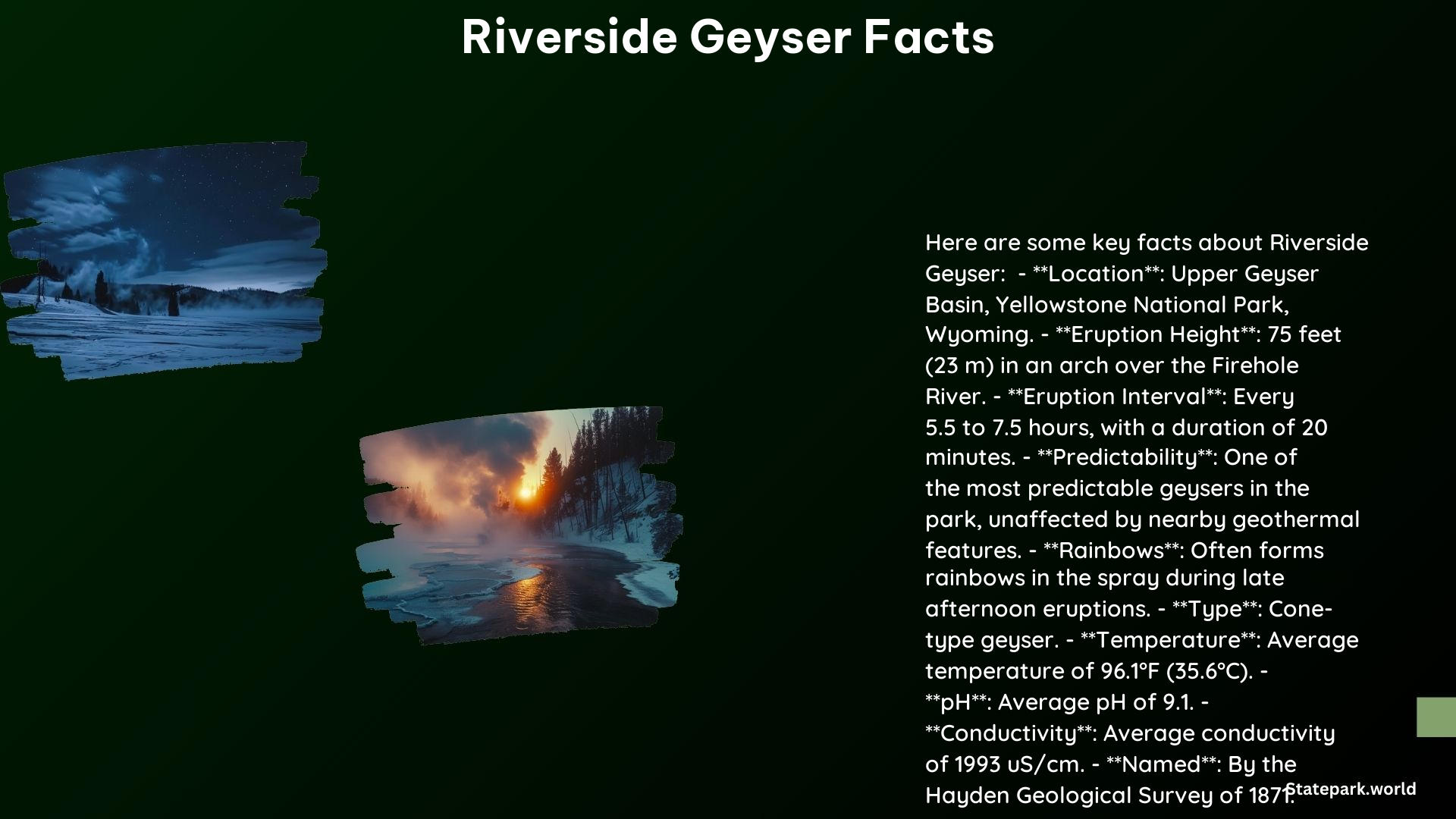Riverside Geyser is a captivating natural wonder located within Yellowstone National Park, known for its predictable eruption patterns, stunning visual displays, and unique geological features. As a must-see attraction for park visitors, understanding the key facts about this geyser can enhance your appreciation and enjoyment of this remarkable natural phenomenon.
Riverside Geyser Eruption Characteristics
Riverside Geyser is a cone-type geyser that erupts with remarkable consistency, making it a reliable and popular sight for visitors. Some of the key facts about its eruption characteristics include:
- Eruption Height: The geyser shoots steam and water to heights of 75 feet (23 meters) in an arching pattern over the Firehole River.
- Eruption Interval: Riverside Geyser erupts every 5.5 to 7.5 hours, with a typical interval of 6 hours and 20 minutes (± 30 minutes).
- Eruption Duration: Each eruption lasts approximately 20 minutes.
Riverside Geyser Rainbows

One of the most captivating features of Riverside Geyser is the stunning rainbows that often appear in the spray during its eruptions, particularly during late afternoon displays. The combination of the geyser’s arching water plume and the sunlight creates these breathtaking natural light shows, making it a must-see for visitors.
Riverside Geyser Accessibility and Location
Riverside Geyser is located within the Upper Geyser Basin of Yellowstone National Park, situated along the Firehole River. The geyser can be accessed by following a paved walking/bike path, which is approximately a mile from the iconic Old Faithful Geyser.
Riverside Geyser Geological Features
Riverside Geyser is a cone-type geyser, with a unique cone structure that includes an upper and lower part. The lower part is responsible for the main eruptions, while the upper part occasionally splashes prior to an eruption. This distinctive geological feature contributes to the geyser’s predictable and reliable eruption patterns.
Riverside Geyser Safety Considerations
As with any geothermal feature in Yellowstone, it is essential for visitors to exercise caution when viewing Riverside Geyser. Visitors are advised to stay on designated trails and boardwalks, as the hydrothermal water can cause severe burns if encountered. Respecting the park’s safety guidelines and maintaining a safe distance from the geyser is crucial for a enjoyable and memorable experience.
Riverside Geyser Historical Significance
Riverside Geyser was first named by the Hayden Geological Survey of 1871, and it has remained a consistent and reliable feature of Yellowstone National Park over the years. Despite some minor changes in its eruption pattern following the 1959 Hebgen Lake earthquake, Riverside Geyser has continued to captivate visitors with its predictable and visually stunning displays.
Conclusion
Riverside Geyser is a true gem of Yellowstone National Park, offering visitors a unique and reliable natural spectacle. By understanding the key facts about its eruption characteristics, rainbows, accessibility, geological features, and safety considerations, you can fully appreciate the wonder of this remarkable geyser and plan your visit accordingly. Whether you’re a seasoned park enthusiast or a first-time visitor, Riverside Geyser is a must-see attraction that will leave a lasting impression.
References:
– https://en.wikipedia.org/wiki/Riverside_Geyser
– https://yellowstonenaturalist.com/geyser-watch/get-to-know-riverside-geyser/
– https://www.hmdb.org/m.asp?m=88386
– https://www.usgs.gov/media/images/riverside-geyser
– https://www.nps.gov/places/000/riverside-geyser.htm
